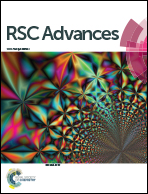Solution copolymerization of ethylene and propylene by salicylaldiminato-derived [O-NS]TiCl3/MAO catalysts: synthesis, characterization and reactivity ratio estimation
Abstract
Salicylaldiminato-derived [O-NS]TiCl3 is used in the copolymerization of ethylene and propylene in toluene solution with methylaluminoxane as the co-catalyst. The effects of temperature, Al/Ti molar ratio and feed ratio of ethylene and propylene on the solution copolymerization and its resulting copolymer structure are investigated. It is revealed that the ethylene content in the resultant copolymers and the copolymerization activity decrease with the increase of propylene addition. The 13C-NMR analysis demonstrates that the copolymers are essentially composed of long ethylene sequences with some isolated propylene units and smaller amount of PP diad. Moreover, the triad distribution data are elaborated in a statistical strategy to determine the reactivity ratios, which are also compared with the first-order direct fit method and the first-order/second-order Markovian methods. The product of monomer reactivity ratio reaches a minimum value of 0.37 at 60 °C, indicating the best temperature for ethylene–propylene copolymerization in this system. The results also indicate that there are hardly penultimate unit effects.
![Graphical abstract: Solution copolymerization of ethylene and propylene by salicylaldiminato-derived [O-NS]TiCl3/MAO catalysts: synthesis, characterization and reactivity ratio estimation](/en/Image/Get?imageInfo.ImageType=GA&imageInfo.ImageIdentifier.ManuscriptID=C6RA27136G&imageInfo.ImageIdentifier.Year=2017)

 Please wait while we load your content...
Please wait while we load your content...